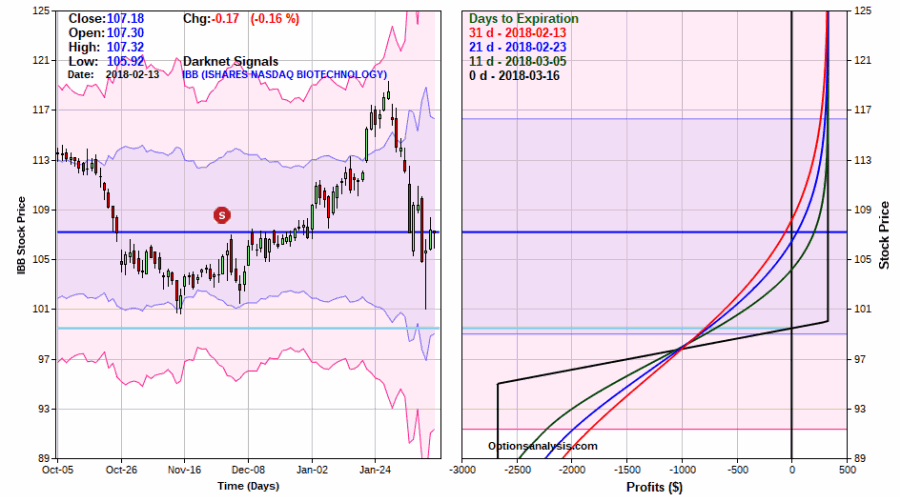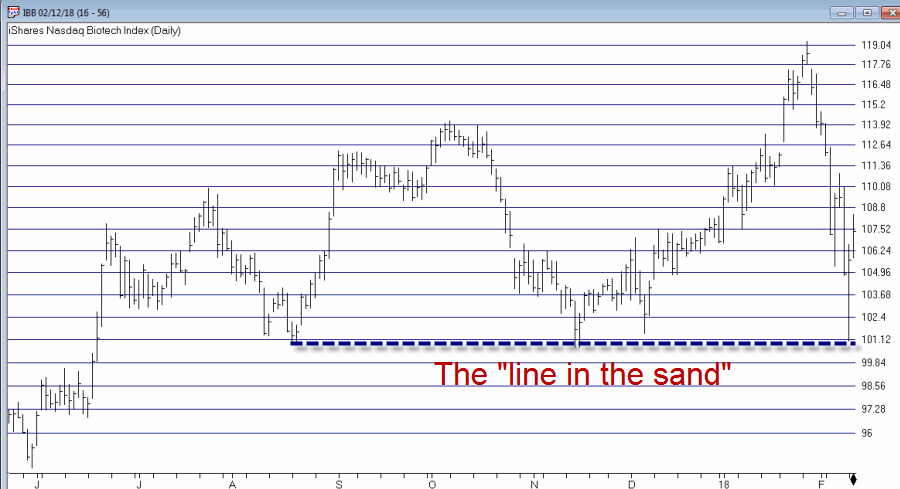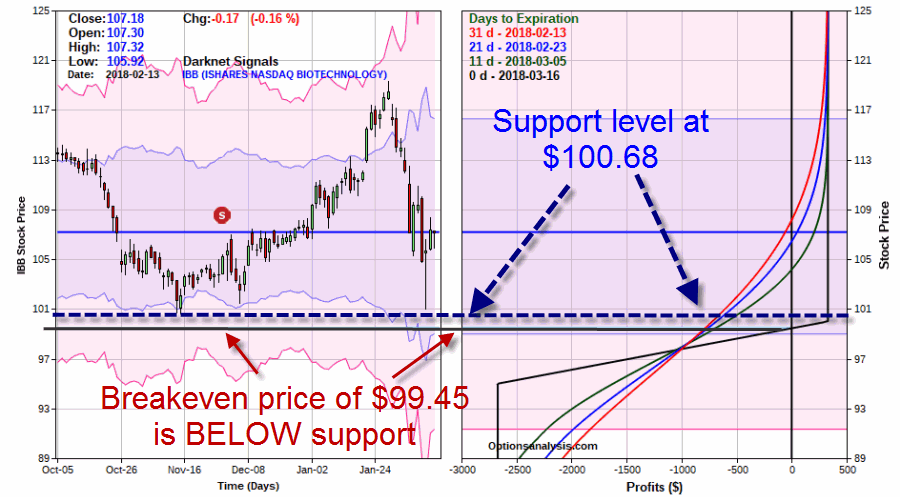OK, if you are pretty sure that you will never trade an option credit spread then “class dismissed”. Thanks for stopping by and please come back again soon.
Alright option junkies, we have the class to ourselves so here is a quick and dirty lesson about one of the most important aspects of establishing a credit spread.
The Short Version
Your stop-loss point for a bull put credit spread should be BELOW an obvious support level to ensure that you do not get stopped out by “market noise”.
The Longer Version
OK wait, first – just in case – for the record, a “bull put” credit spread involves selling a put option with a higher strike price and buying a put option lower strike price put option.
For example, consider the example trade displayed in Figures 1 and 2 which involves:
*Selling 6 IBB March 100 puts @ $1.10
*Buying 6 IBB March 95 puts @ $0.55
For the record, I am NOT “recommending” this trade. It simply serves as a useful example of something I consider important in establishing a credit spread.
 Figure 1 – IBB Bull Put Credit Spread (Courtesy www.OptionsAnalysis.com)
Figure 1 – IBB Bull Put Credit Spread (Courtesy www.OptionsAnalysis.com) Figure 2 – IBB Bull Put Credit Spread risk curves (Courtesy www.OptionsAnalysis.com)
Figure 2 – IBB Bull Put Credit Spread risk curves (Courtesy www.OptionsAnalysis.com)
With IBB trading at $107.18 a share, this trade has:
*31 days left until expiration
*A maximum profit potential of $330 (or 12.36% of risk) which would be realized if IBB closes above $100 a share at expiration.
*A breakeven price of $99.45
*A maximum risk of -$2,670 which would be realized if this trade was held until expiration and IBB was at $95 or below at the time
Because of the lopsided reward/risk it is recommended that a trader establish an “Uncle” point, i.e., a price which, if reached, would cause the trader to exit the trade, presumably with a loss.
OK – finally – here comes “the lesson”.
1) Ideally there should be an obvious support level visible on a chart. As you can see in Figure 3, for IBB that level is $100.67, i.e., the low of the double bottom established in November 2017. Figure 3 – IBB Price chart with support at $100.68
Figure 3 – IBB Price chart with support at $100.68
Now here comes the actual “point”
2) The “breakeven price” and/or your “Uncle” point for a credit spread you are looking do enter should be BELOW the obvious support level that appears on the price chart. (NOTE: you do not have to use the breakeven price as your “Uncle” point. You can choose another price level. However, ideally both price levels should be belowthe obvious support level on chart.)
Why? Because any drop to the obvious support level that does not break out to the downside is nothing more than “noise”. In fact, it could even serve to strengthen the support level if price retests and then holds above support.
3) You DO NOT want to get stopped out by market “noise”.
See Figure 4.
 Figure 4 – IBB Bull Put Credit spread with breakeven price below support (Courtesy www.OptionsAnalysis.com)
Figure 4 – IBB Bull Put Credit spread with breakeven price below support (Courtesy www.OptionsAnalysis.com)
1) The obvious support level is $100.68
2) The breakeven price (potential “Uncle” point) is $99.45
3) If market noise takes IBB back down to $100.68 but no lower, this trade will NOT get stopped out.
In Sum: Your stop-loss point for a bull put credit spread should be BELOW an obvious support level to ensure that you do not get stopped out by “market noise”.
Here ends the lesson.
Jay Kaeppel
Disclaimer: The data presented herein were obtained from various third-party sources. While I believe the data to be reliable, no representation is made as to, and no responsibility, warranty or liability is accepted for the accuracy or completeness of such information. The information, opinions and ideas expressed herein are for informational and educational purposes only and do not constitute and should not be construed as investment advice, an advertisement or offering of investment advisory services, or an offer to sell or a solicitation to buy any security.

